
Oil prices climbed on the last trading day of the year on Monday, taking a cue from firmer stock markets, but were on track for the first yearly decline in three years amid concerns of a persistent supply glut.
Hints of progress on a possible U.S.-China trade deal helped bolster sentiment, which has been battered by concerns over a weaker global economic outlook.
Brent crude futures - the international benchmark for oil prices - rose 42 cents, or 0.8 percent, to $53.63 a barrel by 0250 GMT. Brent declined nearly 20 percent in 2018 following two years of growth.
U.S. West Texas Intermediate (WTI) crude futures were at $45.65 a barrel, up 32 cents, or 0.7 percent, from their last close. WTI is down about 24 percent this year.
Crude prices have been closely tracking equity markets during volatile trading for both asset classes last week.
"Investors are looking for bargains in an illiquid market (today)... If Trump gets over trade issues with China expect economic demand to surge," said Jonathan Barratt, chief investment officer at Probis Securities in Sydney.
U.S. President Donald Trump said he had a "long and very good call" with Chinese President Xi Jinping and that a possible trade deal between the United States and China was progressing well.
"China is still the best bet for global economic growth. Anything that severely pinches China will inevitably hurt global growth and, as a consequence, oil consumption," said Sukrit Vijayakar, director of energy consultancy Trifecta.
The current downward pressure on oil prices should likely taper off from January, when OPEC-led supply cuts commence, analysts said.
Earlier this month, the Organization of the Petroleum Exporting Countries (OPEC) and its allies including Russia, agreed to curb output by 1.2 million barrels per day starting in January to clear a supply overhang and prop up prices.
The group of producers "may hold out on supplies longer than reasonable in order to see if they can effect a rally similar to September-October this year," Vijayakar said.
Meanwhile, imports of Iranian crude oil by major buyers in Asia hit their lowest in more than five years in November as U.S. sanctions on Iran's oil exports took effect last month.
Asia's imports from Iran are set to rise again in December after the U.S. granted temporary waivers to some countries, but is not known how much Iran will be able to export once the waivers expire around the start of May.
"We postulate for a gentle recovery for oil prices into the first quarter of 2019 though marked volatility can snap oil prices south in lieu of market uncertainties and key events such as Brexit, U.S.-China trade truce deal, U.S. monetary policy, U.S.-Iran sanctions," said Benjamin Lu Jiaxuan, commodities analyst at Singapore-based brokerage firm Phillip Futures.
Energy companies in the United States, currently the world's biggest oil producer, added two oil drilling rigs in the week to Dec. 28, General Electric Co's Baker Hughes unit said on Friday. That was up from 747 a year ago. The rig count is used as an indicator for future output.








